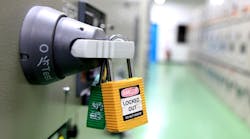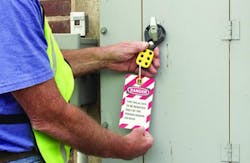Fostering an electrical safety culture
At the end of each year, it is an annual tradition for the Occupational Safety and Health Administration (OSHA) to release the top 10 most cited violations of the year across all industries. However, the year 2020 has proved to be anything but traditional, and the final numbers have yet to be tabulated. Early reports have indicated that the number of violations for Lockout/Tagout (LOTO) have exceeded last year’s; however, until these numbers can be verified by OSHA, we can analyze previous years’ data where the number of violations and their deviation has been minimal.
Veteran safety consultants urge employers to keep an eye out for the annual OSHA Top 10 report. This list is one of the best starting points on the path toward fostering a robust safety culture, as one safety consultant advises. In an interview with Safety+Health magazine, JoAnn Dankert, senior safety consultant at the National Safety Council, said, “Minimally, an employer should have the responsibility of asking, ‘Do any of these Top 10 affect me?’ Because this is the easiest place if our friends from OSHA should come to visit.”
“I think a portion of why we see these over and over again is there’s a lot of parts to many of the standards, which makes it easier for OSHA to cite us if we missed something, and some parts take time to implement,” says Dankert. “They aren’t necessarily bad, but they do take resources, and for smaller organizations, people might be doing HR and safety, or they’re doing facility maintenance and safety. Maybe they’re the person, the admin, that sits in the lobby and they’re trying to do safety on the side.”
When fostering your very own electrical safety culture, start by looking at two of the recurring top 10 most cited OSHA violations that are related to the control of hazardous energy and use of electrical work practices. These are covered under the OSHA regulations: (1) CFR 1910.147, which covers the servicing and maintenance of machines and equipment in which the unexpected energization or startup of the machines or equipment, or release of stored energy, could harm personnel; and (2) CFR 1910.333, which covers the safety-related work practices to prevent electrical shock or other resulting injuries from direct or indirect electrical contact when work is performed around the electrical equipment and circuits.
Failure to perform proper mechanical or electrical LOTOs can lead to electrocution, electrical shock, arc-flash, and other hazards. In addition to huge penalties, these hazards often result in lost time wages, compensation claims, permanent disability, and fatalities. The U.S. Department of Labor from 2011 to 2015 reported an average of 150 fatalities per year in the United States due to “exposure to electricity” and more than 50,000 are injured for disregarding LOTO protocols. The Bureau of Labor Statistics also reported an average of 2,370 non-fatal electrical injuries a year due to electrical shock and electrical burns in the last decade.
Despite the potential for preventing an estimated 150 fatalities and 50,000 injuries each year, LOTO procedures consistently account for one of the most cited OSHA violations each year. In 2019, the LOTO Standard 29 CFR 1910.147 “Control of Hazardous Energy” placed fourth in OSHA’s top 10 list of most cited violations with 2,975 total violations: higher than the previous year. This standard outlines minimum performance requirements for the control of hazardous energy during servicing and maintenance of machines and equipment.
Employers cited under this standard failed to establish an energy control procedure either partially or altogether, while others were cited for failing to provide adequate employee training, failing to conduct periodic evaluations of procedures, and failing to use LOTO devices or equipment. Violations were common among plastics manufacturers, machine shops, and sawmills. Penalties for 2019 citations can cost as much as $13,260 per violation and failure to act can lead to additional fines up to $13,260 per violation per day past the deadline to fix the issue.
At the National Safety Council 2019 Congress & Expo, Patrick Kapust, deputy director of OSHA’s Directorate of Enforcement Programs reported: “These are common violations that we’re finding – they’ve been in place for a lot of years. The answers are out there, and employers shouldn’t feel like these are very complex issues. If you don’t know the answers, we encourage you to contact OSHA.”
Since 2014, OSHA has issued employers more than 10,000 LOTO citations. In addition to the penalties paid for safety violations, preventable workplace incidents involving the release of stored energy cost companies millions in lost productivity, medical expenses, and insurance costs. With the available resources today, these completely preventable accidents and their associated costs should be on the downturn as opposed to 2019 seeing an increase in violations over the previous years. Employers are consistently failing upwards to comply with minimum performance requirements, and it’s becoming more apparent that we’re far past the time for them to adopt Safety-By-Design solutions.
Striving for the minimum requirements of compliance does not lead to achieving minimum risk or maximum productivity levels available today. Furthermore, human error plays a vital role in failing to comply with standards. Despite thorough training, documentation, and experience, there will always exist that risky margin of a person just simply making a mistake, no matter how many times they have performed the task at hand.
Qualified maintenance personnel performing mechanical LOTO are tasked with isolating electrical energy. As part of the verification of de-energized condition, OSHA requires a person to operate the equipment controls, also known as a try/test, to ensure the equipment cannot be restarted. There are several significant risks associated with solely relying on the try/test. These risks often include isolating wrong controls, accidental restart of the equipment, getting caught in the equipment, or contact with a live source of energy at the machine level.
Safety conscious and forward-thinking companies understood these risks early on and started to require electricians to perform absence of voltage testing for mechanical LOTO. With the advent of the National Fire Protection Association (NFPA) 70E and research on arc flash, companies began to realize through job hazard analysis that this task, while reducing the hazards of the energized condition of the equipment on the other hand, greatly increased the workers’ exposure to electricity in performing the test itself. Additionally, the involvement of an electrician in a simple mechanical LOTO further hampered productivity.
In addition to the OSHA required try/test, an externally mounted LED voltage presence indicator provides a means to verify the voltage presence inside an electrical panel safely from the outside. Without a voltage indicator, a mechanic performing mechanical LOTO would be required to work in tandem with an electrician using a voltmeter to physically verify voltage inside an electrical panel. In this case, the electrician is exposed to voltage. With the combination of the try/test and thru-door LED voltage presence indicators, the mechanic can solely verify de-energized condition without any voltage exposure.
Fostering a robust electrical safety culture goes beyond legislation and compliance. An environment that is highly productive and efficient is a culture where employees are safe, secure, and cared for. According to the U.S. Department of Labor, a safe and healthy workplace not only protects workers from injury and illness, but it can also lower injury/illness costs, reduce absenteeism and turnover, increase productivity and quality, and raise overall employee morale.
In other words, fostering a safety culture is not just a good practice, it is good for business.
Nick Schiltz is a copywriter for Grace Technologies, located in Davenport, IA. The company specializes in electrical safety products and predictive maintenance solutions. During his five years at Grace, Schiltz has published more than 250 blog posts ranging in topics from electrical safety best practices to the future impact of IIoT in the industrial space. You can read more of Schiltz’s work on Grace’s weekly electrical safety and reliability maintenance centered blog, Humpday: https://www.graceport.com/blog.

